| Revision as of 14:04, 13 October 2013 edit46.212.19.199 (talk)No edit summary← Previous edit | Revision as of 18:00, 22 October 2013 edit undoEboireau (talk | contribs)132 edits Updated to new EU regulation (GSH pictograms/Labeling; ADR pictograms/Transportation)Next edit → | ||
| Line 1: | Line 1: | ||
| ]'' ( |
]/]'' (HSH05)]] | ||
| The '''] for chemicals''' are pictograms defined by the ] for labeling chemical packagings (for storage and workplace) and containers (for transportation). They are standardized currently by the CLP/GHS classification. | |||
| ⚫ | == CLP & ADR / GHS hazard pictograms == | ||
| ⚫ | |||
| The European Union ] (for "Classification, Labelling and Packaging" was introduced through the european directives (EC) N°1272/2008. It is based on the ]. | |||
| See main article ''']'''. | |||
| {{update|date=June 2012}} | |||
| <gallery> | |||
| ⚫ | The ] (ADR) fixed harmonized pictograms for transportation. Vehicles carrying dangerous goods have to be fitted with orange signs, where the lower number identifies the substance, while the upper number is a key for the threat it may pose. See former pictograms below. | ||
| Image:Hazard E.svg|'']'' ('''E''') | |||
| Image:Hazard O.svg|'']'' ('''O''') | |||
| See main article ''']''' (and ]) | |||
| Image:Hazard F.svg|''Highly ]'' ('''F''') | |||
| Image:Hazard FF.svg|''Extremely ]'' ('''F+''') | |||
| == Former hazard pictograms == | |||
| Image:Hazard T.svg|'']'' ('''T''') | |||
| * Europe 1999 - 2007 | |||
| Image:Hazard TT.svg|''Very ]'' ('''T+''') | |||
| The hazard symbols for chemicals were defined in Annex II of ]. A consolidated list with translations into other EU languages was be found in Directive 2001/59/EC (See the links section). | |||
| Image:Hazard X.svg|''Harmful'' ('''Xn''') | |||
| Image:Hazard Xi.svg|'']'' ('''Xi''') | |||
| Image:Hazard C.svg|'']'' ('''C''') | |||
| Image:Hazard N.svg|''Dangerous for the environment'' ('''N''') | |||
| </gallery> | |||
| ⚫ | The ''''n'''' in Harmful ('''Xn''') stands for the French word ''nocif'' (harmful) and the Italian word ''nocivo'' (noxious). | ||
| {| class="wikitable" | {| class="wikitable" | ||
| |+] standard Hazard pictograms for labeling - Europe UE 67/548/CEE, 1999/45/CE | |||
| |- | |- | ||
| ! Hazard pictogram & ''mention'', '''code''' <br/> !! Substances examples | |||
| ! Hazard !! Substance | |||
| |- | |- | ||
| | |
| ]'' ]'' ('''E''') || ], ], ], ] | ||
| |- | |- | ||
| | Extremely flammable (F+) |
| ]''Extremely ]'' ('''F+''')|| ], ], ], ], ], ], ] | ||
| |- | |- | ||
| | |
| ]''Extremely ]'' ('''F''') || ], ], ], ], ] | ||
| |- | |- | ||
| | Oxidizing (O) |
| ]'']'' ('''O''') || ], ], ], ], ] | ||
| |- | |- | ||
| | Toxic (T) |
| ]'']'' ('''T''') || ], ], ], ], ], ], ] | ||
| |- | |- | ||
| | Very toxic (T+) |
| ]''Very ]'' ('''T+''') || ], ], ], ] | ||
| |- | |- | ||
| | Harmful (Xn) |
| ]''Harmful'' ('''Xn''') || ], ], ], ] | ||
| |- | |- | ||
| | Irritant (Xi) |
| ]'']'' ('''Xi''') || ], ], ] | ||
| |- | |- | ||
| | Corrosive (C) |
| ]'']'' ('''C''') || ], ], ], ], ] | ||
| |- | |- | ||
| | Dangerous for the environment (N) || ], ], ], ] | | ]''Dangerous for the environment'' ('''N''') || ], ], ], ] | ||
| |} | |} | ||
| ⚫ | The ''''n'''' in Harmful ('''Xn''') stands for the French word ''nocif'' (harmful) and the Italian word ''nocivo'' (noxious). | ||
| * German hazard symbols < 1999 | |||
| {| class="wikitable" | {| class="wikitable" | ||
| |+] standard ] 4844-2 | |+] standard ] 4844-2 | ||
| Line 88: | Line 87: | ||
| |} | |} | ||
| == See also == | |||
| * ] | |||
| ⚫ | |||
| ==External links== | ==External links== | ||
Revision as of 18:00, 22 October 2013
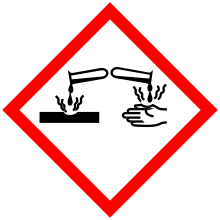
The Hazard symbol for chemicals are pictograms defined by the European community for labeling chemical packagings (for storage and workplace) and containers (for transportation). They are standardized currently by the CLP/GHS classification.
CLP & ADR / GHS hazard pictograms
The European Union CLP Regulation (for "Classification, Labelling and Packaging" was introduced through the european directives (EC) N°1272/2008. It is based on the GHS system.
See main article GHS hazard pictograms.
The European Agreement concerning the International Carriage of Dangerous Goods by Road (ADR) fixed harmonized pictograms for transportation. Vehicles carrying dangerous goods have to be fitted with orange signs, where the lower number identifies the substance, while the upper number is a key for the threat it may pose. See former pictograms below.
See main article ADR pictograms (and GSH Transport_pictograms)
Former hazard pictograms
- Europe 1999 - 2007
The hazard symbols for chemicals were defined in Annex II of Directive 67/548/EEC. A consolidated list with translations into other EU languages was be found in Directive 2001/59/EC (See the links section).
| Hazard pictogram & mention, code |
Substances examples |
|---|---|
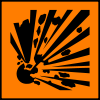 Explosive (E) Explosive (E) |
TNT, acetone peroxide, nitroglycerin, picric acid |
 Extremely Extremly Flammable (F+) Extremely Extremly Flammable (F+) |
Hydrogen, acetylene, propane, butane, diethyl ether, carbon disulfide, ethanal |
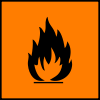 Extremely Flammable (F) Extremely Flammable (F) |
Ethanol, acetone, gasoline, hexamine, methanol |
 Oxidizing (O) Oxidizing (O) |
Oxygen, potassium nitrate, hydrogen peroxide, nitric acid, potassium permanganate |
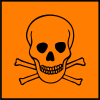 Toxic (T) Toxic (T) |
Sulfuric acid, TNT, Nitroglycerin, carbon disulfide, methanol, ammonia, methanal |
 Very toxic (T+) Very toxic (T+) |
Prussic acid, nicotine, carbon monoxide, white phosphorus |
 Harmful (Xn) Harmful (Xn) |
Hexamine, butane, naphtha, ethanal |
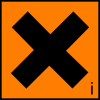 Irritant (Xi) Irritant (Xi) |
Sodium hypochlorite, acetone, ethanol |
 Corrosive (C) Corrosive (C) |
Sulfuric acid, Nitric acid, sodium hydroxide, ammonia, White phosphorus |
 Dangerous for the environment (N) Dangerous for the environment (N) |
Sulfuric acid, turpentine, lead, mercury |
The 'n' in Harmful (Xn) stands for the French word nocif (harmful) and the Italian word nocivo (noxious).
- German hazard symbols < 1999
 Block magnet |
 Explosive |
 Poison |
 Ionizing radiation |
 Suspended load |
 Truck driving |
 Self ignition |
 Electromagnetic radiation |
 Tripping danger |
 Falling hazard |
 Biohazard |
 Health danger and irritant |
 Dangerous batteries |
 Explosive atmosphere |
 Pinch |
 Can tip over when moving |
 Remotely Starting |
 Hand pinching |
 Slippery |
 Driven by conveyor belt inside the track |
 Entanglement hazard |
 Corrosive |
 Gas bottle |
 Cold |
 Laser radiation |
 Potential danger |
 Flammable |
 Electrical danger |
 Hot surface |
 Magnetic field |
 Optical radiation |
 Tsunami |
||||
External links
- commons.wikimedia.org - Category: Safety signs
- commons.wikimedia.org - Category: DIN-style signs (vector drawings)
- commons.wikimedia.org - Category: DIN_4844-2 warning signs (vector drawings)
- commons.wikimedia.org - Category: ISO 7010 safety signs (vector drawings)